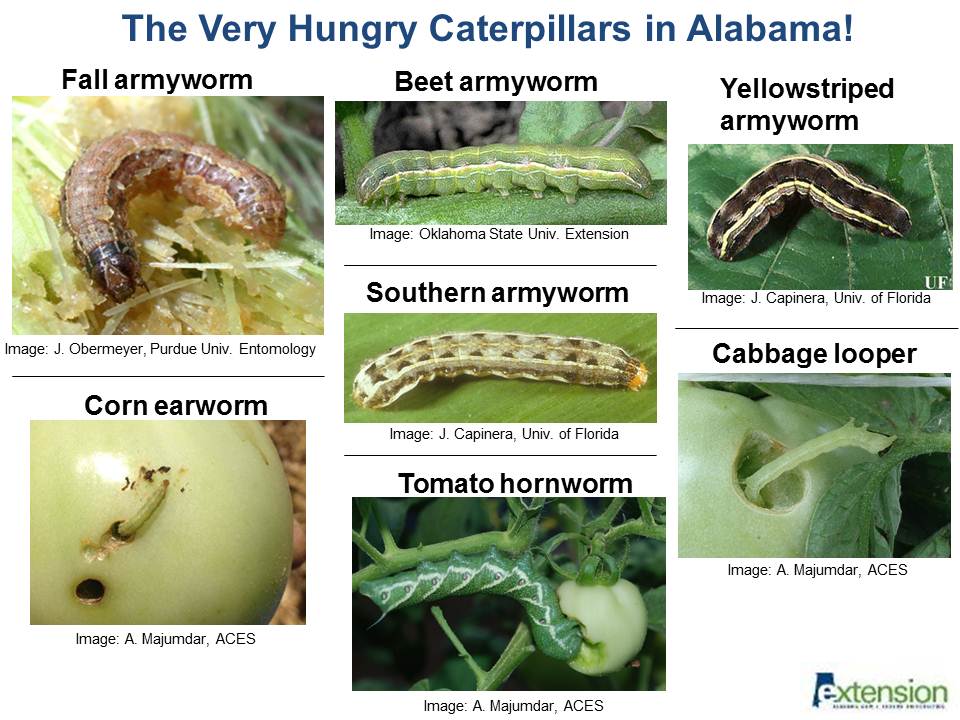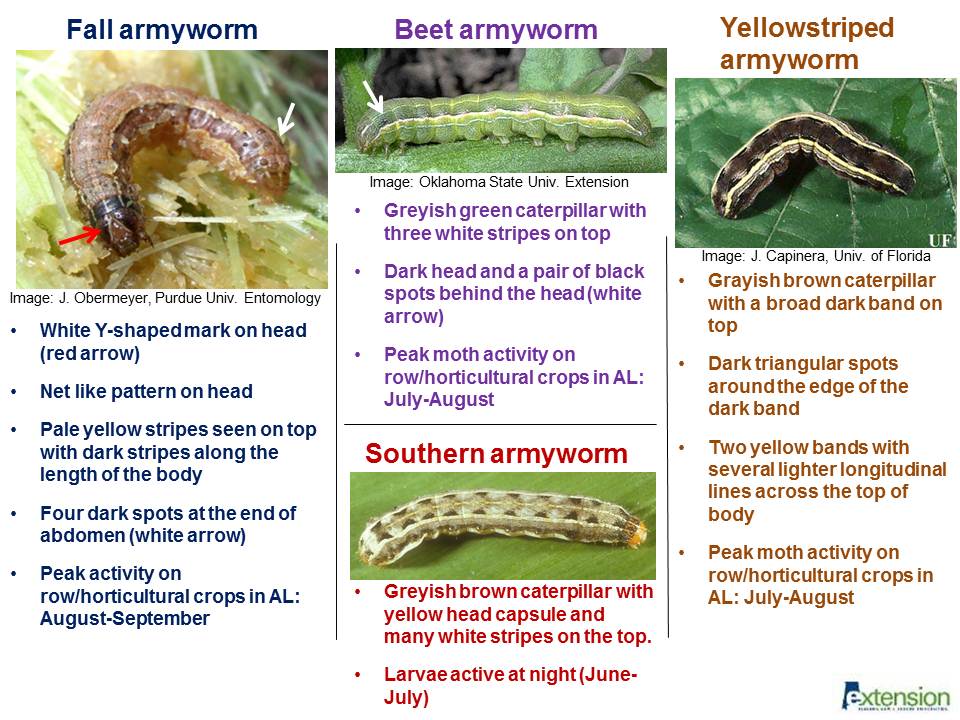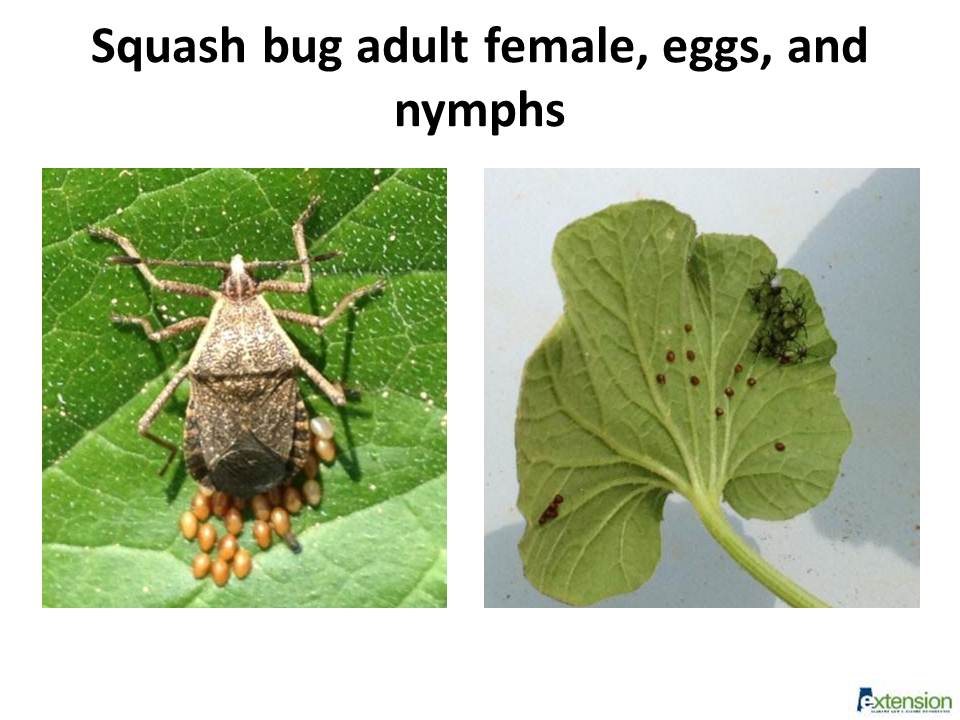 Ayanava Majumdar (Dr. A), Alabama Extension Entomologist
Ayanava Majumdar (Dr. A), Alabama Extension Entomologist
Source: Alabama IPM Communicator Newsletter
Drought-like conditions is favoring plant-stress and a high incidence of caterpillars on vegetable crops. Insects undergo a rapid life cycle in hot conditions – this can be worse in protected structures with the humidity plus heat. There are several armyworm species active now. We have definitely detected beet armyworm (BAW) activity in vegetable fields with moth numbers ranging 4 to 14. BAW caterpillars have a small dark spot on each side of the body behind the head. Producers may start seeing extensive BAW caterpillar feeding on leaves, followed by feeding on immature fruiting structures. Fall armyworms (FAW) prefer the grass family crops and later migrate to row and horticultural crops. FAW caterpillars are brown with a net-like pattern on their head and a pale yellow band on the top of body. FAW activity appears to be lagging behind BAW activity in crops. Eventually producers will find the yellowstriped armyworm (YAW) on specialty crops; YAW is easily identified from the dark brown body with two bright yellow bands and black triangular spots. Below is a photo of the three commons species to help you compare them. Eggs are generally laid in masses on the underside of leaves.
We have started to notice intense corn earworm (CEW) or tomato fruitworm feeding injury on high tunnel crops. Some feeding from the tomato hornworm (THW) may also be seen in certain areas in the south and central AL. Both these insects lay eggs singly on leaves or fruits. Based on moth trap catches, we have only detected them in low numbers (range 0 to 2 moths); however, considering the fact that female moths can lay about 500 eggs you may have plenty of caterpillars already. Look for the clean round entry holes for the CEW caterpillars on the top of the fruit near the sepals. Most of the time these caterpillars may be feeding with their body partially inside the fruit but sometime the caterpillar may decide to enter the fruit through a large feeding hole and escape your spray treatment in the process. Keep scouting for larvae and small feeding holes for quick detection – then act fast to control caterpillars because they will go from plant-to-plant and from one end to the other end in a high tunnel, devastating the crop.
Side-note: We have seen plenty of squash bug adults and egg masses shown in the picture below. It is never a good idea to have too many squash bugs since they suck plant sap and transmit the yellow vine decline disease that kills the fruiting vine suddenly. High heat aggravates the injury and plants may succumb to the feeding fast.
Control methods in vegetables:
Pest exclusion for organic gardeners and producers: Pest Exclusion really works well for keeping armyworms, hornworm, and fruitworm moths small gardens, raised beds, and high tunnels in the short- or long-term. Check out the high tunnel pest exclusion (HTPE) webpage for a permanent pest exclusion recommendation. Gardeners can look up the pest exclusion basics webpage for learning about low-cost temporary pest exclusion method.
Organic insecticide treatment for large acres: Identify the caterpillar correctly – then treat if necessary. Xentari® or Dipel® (both Bt-products) work very well for CEW and THW; Xentari ® is very effective on BAW and FAW, plus other caterpillars. You can also tank-mix Bt with PyGanic (Natural Pyrethrin) or rotate with the insecticides. Whenever you spray Bt, don’t quit before two applications and give it time to kill the insect. Stop spraying when caterpillar numbers are low. Spinosad (Entrust) is also effective against caterpillars and will also kill thrips and other small insect pests. If you detect caterpillars early and spray weekly with a good insecticide rotation and spray coverage, then you can avoid a major caterpillar outbreak. Do not target the moths with any of the applications.
Conventional insecticides: Refer to Vegetable Handbook (see below) for full recommendations on insecticides. Several synthetic pyrethroids work well against most caterpillars (armyworms can be hard to kill). Alpha cypermethrin (Fastac®) and zeta cypermethrin (Mustang Max®) work well for most species mentioned here, but avoid over-spray to avoid insecticide resistance and getting spider mites. Spinetoram (Radiant ®) is excellent in the late-season high-pressure situation for protecting fruiting structures with long residual action. Producers can rotate Bt-based products (Xentari® as two early applications) followed by synthetic formulations and/or spinetoram as pest-pressures increase during the season.
When in doubt, contact your Extension Agent for specific control recommendations. Remember to use your cell phone camera to capture images and send them on to an agent for quick identification.
Useful resources:
-
Identifying caterpillar in field, forage, and horticultural crops (bulletin with many good pictures)
-
Tomato insect pests and scouting methods (ANR-2206)
-
SE Vegetable Crop Production Handbook (2016)
-
Alternative Vegetable IPM Recommendation Slide Chart
(Call Dr. A at 251-331-8416 for a copy)
- September 2025 Weather Summary and Last Quarter Outlook - October 10, 2025
- What to See at the 2025 Sunbelt Ag Expo – October 14-16 - October 10, 2025
- Friday Feature:Trade War with China Hits Soybean Farmers Hard - October 10, 2025


